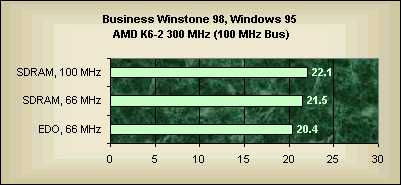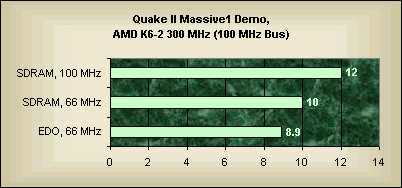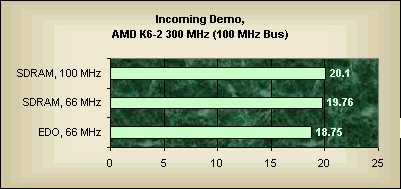K6-2 Performance Guide
The Memory Issue: 66 Vs. 100 MHz Bus
The first thing to consider is the memory question. Motherboards based on the ALi Aladdin V chipset usually are slightly faster than MVP3 chipset boards when equipped with 512 kB L2 cache. However, equipped with 1 MB of L2 cache, boards with the VIA MVP3 chipset currently represent the top of socket 7 performance. And they have another nice feature: The SDRAM clock can be either synchronous to the system clock or asynchronously, at the same frequency as the AGP bus. As you can imagine this allows more independence from the memory: On the one hand you can still use your tried and tested EDO which certainly was all but cheap still some years ago or 10/12/15 ns SDRAM memory. On the other hand you don't necessarily have to go for PC-100 memory just to achieve an overall performance gain of approximately 3% which hardly anybody will notice.
The follwing system consists of an AOpen AX59Pro with VIA Apollo MVP3 chipset and 512 kB L2 cache, 64 MB RAM, ATI Xpert@Work 4 MB AGP and Quantum Fireball ST 3.2 GB Ultra-DMA 2 harddisk.
The domain of AMD's K6-2 certainly is Windows 95 or 98, so I gave up benchmarking in Windows NT. The K6-2 is meant to be a gaming and multimedia CPU, and the only operating system which is fulfilling these demands is Windows 95/98.
You may ask why I didn't benchmark with a faster 3D card. I could have also used a Voodoo2 card, but the gaming performance becomes so high - particularly in Quake II - that the interesting differences would perish, and since I didn't want to test 3D accelerators but the system at divergent configurations I gave up doing this.
Reference is this system running at 100 MHz FSB and 100 MHz SDRAM clock. If you still have standard 10 or 12 ns SDRAM DIMMs (PC-66) I would recommend to use them, since you can see similar resluts as with Pentium II systems: What primarily counts is the L2 cache; it should run as fast as possible. The memory performance is less important for business applications. SDRAM clocked at 66 MHz instead of 100 leads to less than 3% performance decrease, in my eyes just peanuts. If you use even slower EDO memory, the loss is around 7%, but still no reason to worry about.
The situation becomes interesting for all Quake II gamers: If you don't take advantage of the 100 MHz memory option, Quake II runs at 10,0 frames per second instead of 12,0 fps with the higher bus speed, that's about 16% slower. You even lose 26% performance with EDO memory. Using a 3Dfx add-on card eases this performance deficit, but if you had already thought about getting new RAM as well, this could convince you that maybe it's time for some new memory.
Incoming is quite memory independent: The loss is narrowly 2% in case of 66 MHz SDRAM and around 6% for EDO RAM. I think you can easily forget about those small differences.
Get Tom's Hardware's best news and in-depth reviews, straight to your inbox.
Current page: The Memory Issue: 66 Vs. 100 MHz Bus
Next Page 512 kB Or 1 MB 2nd Level Cache
Patrick Schmid was the editor-in-chief for Tom's Hardware from 2005 to 2006. He wrote numerous articles on a wide range of hardware topics, including storage, CPUs, and system builds.


